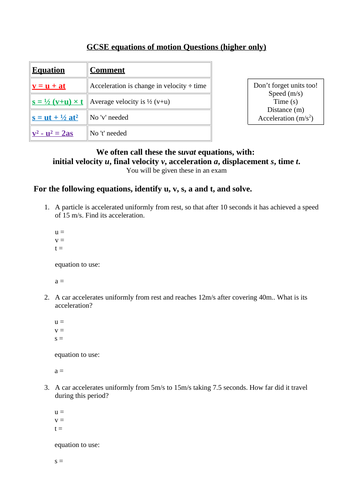SUVAT (or sometimes written as SUVA) is an acronym that stands for five kinematic variables that are commonly used to describe the motion of an object: displacement (S), initial velocity (U), final velocity (V), acceleration (A), and time (T). These variables are often used in physics to analyze the motion of objects, and they are related to one another by a set of equations known as the SUVAT equations.
The five SUVAT equations are:
- S = U*T + (1/2)AT^2
- V^2 = U^2 + 2AS
- S = (U+V)*T/2
- V = U + A*T
- T = (V-U)/A
These equations can be used to solve for any one of the five variables if the other four are known. For example, if you know the initial velocity, final velocity, acceleration, and time of an object's motion, you can use the first equation to solve for the displacement.
SUVAT questions are often found on physics exams, and they typically involve using the SUVAT equations to solve for one or more of the variables. These questions can be challenging, as they often require a strong understanding of the underlying concepts and the ability to manipulate the equations to solve for the desired variable.
To solve a SUVAT question, you will typically need to start by identifying which of the five variables you are trying to solve for. Once you have identified the variable you are trying to solve for, you can use the appropriate SUVAT equation to solve for it. You will need to plug in the values of the other four variables and then perform any necessary calculations to solve for the desired variable.
It is important to note that the SUVAT equations are only valid for objects that are moving in a straight line with a constant acceleration. If the object's motion is more complex, other equations and techniques may be needed to analyze the motion.
Overall, SUVAT questions are a useful tool for understanding and analyzing the motion of objects. By mastering these equations and the underlying concepts, you will be well-equipped to solve a wide range of physics problems involving motion.






